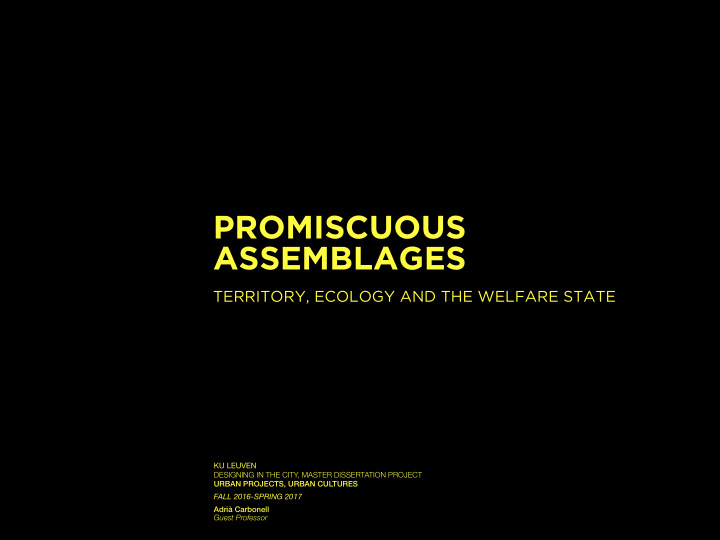



PROMISCUOUS ASSEMBLAGES TERRITORY, ECOLOGY AND THE WELFARE STATE KU LEUVEN DESIGNING IN THE CITY, MASTER DISSERTATION PROJECT URBAN PROJECTS, URBAN CULTURES FALL 2016-SPRING 2017 Adrià Carbonell Guest Professor
THEORETICAL FRAMEWORK
promiscuous • demonstrating or implying an unselective approach; indiscriminate or casual. • consisting of a wide range of different things. assemblage • a collection or gathering of things or people. • a machine or object made of pieces fitted together. • a work of art made by grouping together found or unrelated objects.
The term assemblage can be used in its most descriptive sense, as a collection or gathering of things and people, or in the more elaborated concept built by several scholars (Deleuze and Guattari, 1987; Sassen, 2006) a contingent ensemble of practices and things that can be differentiated and that can be aligned along the axis of territorialisation and deterritorialization, i.e. particular mixes of technical and administrative practices that “extract and give intelligibility to new spaces by decoding and encoding milieu” (1987: 504-5).
TERRITORY
Rather than boundaries being the distinction between place and space, or land or terrain and territory, boundaries are a second-order problem founded upon a particular sense of calculation and concomitant grasp of space. Territory then can be understood as a political technology: it comprises techniques for measuring land and controlling terrain, and measure and control – the technical and the legal – must be thought alongside the economic and strategic. Elden, 2010 .
Thus, the territory, as opposed to the field of extended urbanization, arises as a new ground for architecture. As Paola Viganò put it, “Territory is not the sole support for different political and institutional forms: it is an artefact, a principle of organisation with social origins and characters. It is a collection of particular places and positions; it is a resource, where goods, services, and values are produced. […] it is a space of appropriation, and individual and collective construct and imaginary.” Viganò, 2014:10.
ECOLOGY
The only true response to the ecological crisis is on a global scale, provided that it brings about an authentic political, social and cultural revolution, reshaping the objectives of the production of both material and immaterial assets. Guattari, 1989: 28.
Ecological thinking has proved that all kind of life in the planet is enmeshed in a net of complex and dynamic relations, questioning the idea of nature as a lineal system, where notions of process, temporality and interaction play a fundamental role. Despite claims of its objectivity, though, ecology is never ideologically (or imaginatively) neutral. It is not without values, images or effects. Instead, ecology is a social construction, one that can initiate, inform, and lend legitimacy to particular viewpoints (from “green politics” to nationalism to feminism, for example»). Corner, 1997: 43.
WELFARE STATE
The citizens should be made to desire the appropriate things, so as to generate a control that would also emerge from below. […] As Richard Hamilton claimed, we should not design for the consumer without first designing a consumer, or producing a new desiring subjectivity that consumes. This is also the project in acceptera , even though it is carried out through the commodity, and not, as in Hamilton’s case, through marketing. (Mattsson, Wallenstein, 2010)
Just as the welfare state is incessantly being modified, so is the relationship between welfare and architecture. It is thus relevant to revisit what it means to bring “form” to welfare – that is, to reanalize how and why we design welfare state services. (Søberg, 2015)
STOCKHOLM ARCHIPELAGO
STUDENTS WORK

Recommend
More recommend